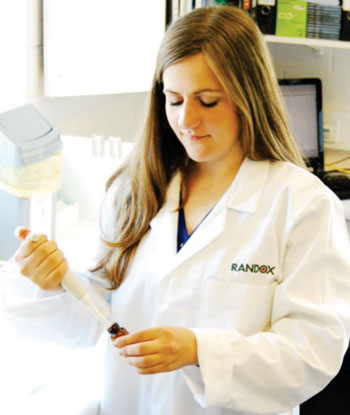Calibration First Vital Step to Reliable Lab Results
By LabMedica International staff writers
Posted on 04 Jun 2014
A quality control (QC) consultant has reemphasized the obvious but still often overlooked importance of performing high-quality calibrations to provide physicians and patients with accurate laboratory results.Posted on 04 Jun 2014
Randox Laboratories (Antrim, Northern Ireland, UK) has called for greater laboratory focus on calibration as the first and vital step to providing quality test results. In a recent multi-location series of QC talks, Sarah Kee, QC Scientific Consultant at Randox, noted that the importance of calibration is often overlooked and stressed that accurate calibration is the foundation for producing reliable results for patients. She added that as the first step in assuring ongoing accurate instrument and reagent performance, calibration is something many clinical laboratories need to give more resources, attention, and thought to.

Image: Sarah Kee, Quality Control Scientific Consultant at Randox, has given a series of talks about the often overlooked importance of accurate calibration in providing reliable test results for patients (Photo courtesy of Randox).
Effective calibration gives laboratory analyzers a baseline from which accurate results can be produced. Labs run calibrators (standards) with known values which establish an instrument baseline. The instrument uses this baseline to adjust readings to match the computed value, and from this point accurate results are reported.
However, calibration can be a double-edged sword. Ms. Kee stressed that the quality of the calibrator material directly underpins the successfulness of the calibration. “Consider the situation where the calibrator’s assigned values are inaccurate or the matrix of the calibrator is different to that of a patient sample. Calibration will establish an incorrect instrument baseline, meaning subsequent patient results will be inaccurate,” said Ms. Kee.
To ensure that any given instrument is establishing a reliable baseline and that the laboratory builds and maintains a strong foundation for accurate patient results, Ms. Kee encourages frequent recalibration and closely following instrument and reagent manufacturers' instructions. She also recommended incorporation of the following practices: to use a third-party calibrator, with independently assigned values, and that it is not optimized to work with any specific instrument or reagent system. To use a calibrator with the same (or close as possible) matrix as the patient sample, e.g., when calibrating tests used for urinalysis ensure that a urine-based calibrator is selected. Wherever possible, choose calibrators that are made from 100% human material—particularly important in antibody-based tests, and wherever possible, use a multianalyte calibrator with a long shelf-life to save time, money, labor, and materials.
Related Links:
Randox Laboratories














